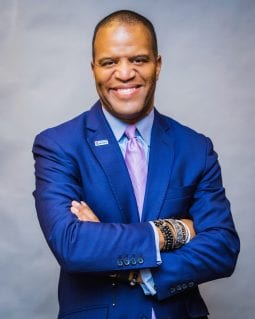Operation Hope Founder Brings Urgency To Financial Inclusion With Shopify Partnership

 Some people fit their names perfectly. John Bryant’s middle name is “Hope.” Not only is it his legal, given name, it is also a concept and practice he brings to the organization he founded in 1992 to lift underserved populations into the formal financial system. For those people, the ones who benefit from the work of Atlanta’s Operation Hope, he is an advocate. For the financial services business, he is an innovator and a provocateur, urging the private sector to bridge the opportunity gap between the rich and the poor. Put simply: John Hope Bryant is riding a good deal of momentum as America’s foremost proponent of financial inclusion.
Some people fit their names perfectly. John Bryant’s middle name is “Hope.” Not only is it his legal, given name, it is also a concept and practice he brings to the organization he founded in 1992 to lift underserved populations into the formal financial system. For those people, the ones who benefit from the work of Atlanta’s Operation Hope, he is an advocate. For the financial services business, he is an innovator and a provocateur, urging the private sector to bridge the opportunity gap between the rich and the poor. Put simply: John Hope Bryant is riding a good deal of momentum as America’s foremost proponent of financial inclusion.
Operation Hope bills itself as the nation’s private banker to the working poor and middle class, particularly for African-American communities, “equipping people with the tools and training needed to lift themselves up and out of poverty, empowering them to realize their aspirations.” Bryant believes that poverty and income inequality is putting the entire capitalist system at risk. His new book, “Up From Nothing: The Untold Story of How We (All) Succeed,” offers his vision for a reimagining of poverty as well as a way out of it, which he says is by growing a sustainable middle class powered by opportunity.
“I give a lot of credit to those in the private sector for getting the memo,” Bryant told PYMNTS CEO Karen Webster. He said private companies deserve that credit because they’ve realized that the current income inequality is not sustainable. “The only solution is to upgrade capitalism itself and to use our balance sheets, our budgets, our companies and our moral compass as an asset to help other people come up,” Bryant said.
“Upgrading” capitalism is not just an empty phrase for Bryant and the team at Operation Hope. Bryant has set out two leadership initiatives in this area: One is a “Marshall Plan” to eradicate poverty, playing off the post-World War II policy of using capital to rebuild defeated nations. The second is what he calls the “Five Pillars Of Success for Reclaiming the American Dream: massive education, understanding the numbers, family structure and resiliency, self-esteem and confidence and role modeling. Four of the pillars are fairly self-explanatory. “Understanding the numbers” involves facts and concepts that Bryant believes need to be better understood by the private sector and government agencies. For example, according to Operation Hope research, 63 percent of Americans say they would be unable to afford a $500 car repair or a $1,000 emergency room bill. One of the organization’s services, credit and financial counseling, has helped its clients through workshops, one-on-one counseling and financial coaching. Through this service, 72 percent of clients see a FICO score increase, and 25 percent achieve an above-prime FICO score of 660 or greater after six months of participation.
The Marshall Plan is more tangible. Bryant says his plan can add 1 percent to 2 percent to the U.S. GDP if those in poverty have access to free education from kindergarten through college, with the caveat that recipients find employment upon graduation. Other pillars in his Marshall Plan include financial literacy delivered through entrepreneur-oriented charter schools for the underserved, access to job opportunities delivered through tax credits and access to capital delivered through opportunity zones.
“Capital does not take risks,” Bryant said. “Capital wants to find a safe home. And so, if you hang around nine broke people, you’re going to be the tenth. Alternatively, nine wealthy people hang around another person and they create a tenth wealthy person, irrespective of brilliance, irrespective of intellect. It’s environment. It’s culture. So the question is, how do you expand? How do you create a software upgrade on capitalism?”
Bryant calls his general concept “open-source capitalism.” America cannot be a global superpower when only half of the residents have a high school education, he said. It’s not a sustainable approach, and is indicative of governments and the private sector doing the easy, short-term things rather than the longer-term, more difficult things.
One of Operation Hope’s initiatives is to create one million Black-owned businesses by 2030. According to the U.S. Small Business Administration (SBA), Black-owned businesses represent only 9.5 percent of all businesses in the U.S. During the pandemic, there was a 41 percent decline in that population. In late October, Operation Hope received help on that front from Shopify, as it announced it will provide up to approximately $130 million of resources to help push the initiative over the line. It will help to heal a divide that he says is killing America’s economy.
“Sometimes you don’t see something that’s killing you,” Bryant said. “That was part of the brilliance of Dr. Martin Luther King. He took the problem of inequality and poverty to Washington, D.C. at a time when the nation couldn’t deal with the important issues because they were always dealing with the urgent ones. He made the important feel urgent. I think we’ve done that with the one million new Black business initiative that we launched with Shopify.”
According to Bryant, the Shopify deal has added that sense of urgency and the element of attraction. It’s also accountable and measurable. He says anecdotal evidence is encouraging, with the first benchmarking report slated to be issued in June 2021. Until then, he said, “buckle up.”
